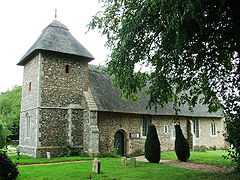Thornham Parva
| Thornham Parva | |
 Church of St Mary |
|
 Thornham Parva |
|
| Population | 50 [1] |
|---|---|
| District | Mid Suffolk |
| Shire county | Suffolk |
| Region | East |
| Country | England |
| Sovereign state | United Kingdom |
| Police | Suffolk |
| Fire | Suffolk |
| Ambulance | East of England |
| EU Parliament | East of England |
Coordinates: 52°18′47″N 1°05′28″E / 52.313°N 1.091°E
Thornham Parva is a village and civil parish in the Mid Suffolk district of Suffolk in eastern England. Located to the north of sister village Thornham Magna and around five miles south of Diss, in 2005 its population was 50.[1]
The tiny thatched Saxon church of St Mary's Thornham Parva has early 14th century wall paintings, on the south wall, the early years of Christ and on the north wall, the martyrdom of St Edmund. There is a circular Saxon window as well as the famous Retable.
The Thornham Parva Retable is the largest surviving altar-piece from the English Middle Ages. It survived the reformers of the 16 th Century, who raged against idolatry and destroyed most of England's medieval culture, by being stored in a barn. It was thought worth saving for future building material. It was discovered between the wars in a wood pile in a Suffolk barn belonging to the local landowner, Lord Henniker. He donated it to the tiny thatched Saxon church of Thornham Parva where his brother was parson.
The origins of the retable were a puzzle but the picture itself provided vital clues. The figures pinpointed links with the Dominican Order. At either end are St Dominic and St Peter Martyr, joint patrons of the Dominicans. St Catherine and St Margaret of Antioch were the order's mascots. The Apostles Peter and Paul, who were believed to have spoken to St Dominic, all point towards Dominican interest. The presence of St Edmund means an East Anglian link. John the Baptist's figure might seem more obscure, but medieval donors demanded value for their money and the benefactors of the Dominican Priory at Thetford, John de Warenne and Edmund de Goneville would have expected their name-sakes to be part of the finished painting.
An altar frontal in the Musée de Cluny in Paris once belonged with the Thornham Parva retable, they must have become separated when Henry VIII dissolved the English monasteries in 1538 and Thetford Priory was itself dissolved.
The retable has recently returned to Thornham Parva church following 7 years of restoration by the Cambridge University team at the Hamilton Kerr Institute. Using sturgeon glue, applied with tiny dabs of cotton buds, inch by inch the layers of grime and botched "restoration" was removed to reveal rich gold and glowing autumnal palette of translucent reds, purples and greens which the original artist used.
References
- ↑ 1.0 1.1 Estimates of Total Population of Areas in Suffolk Suffolk County Council